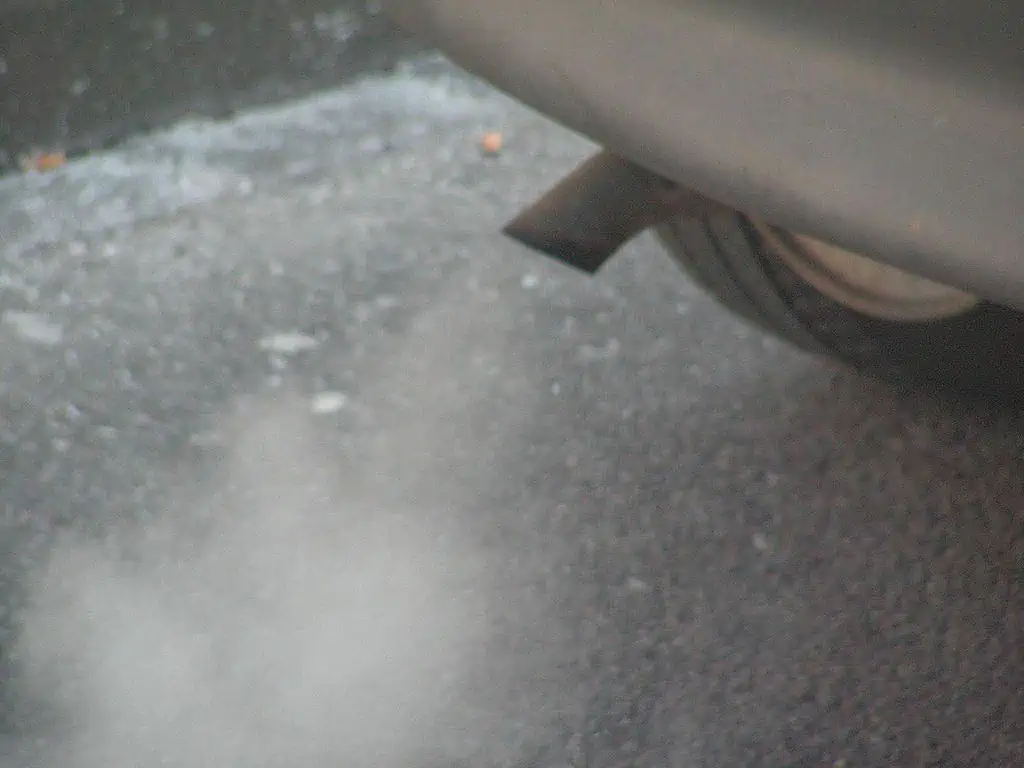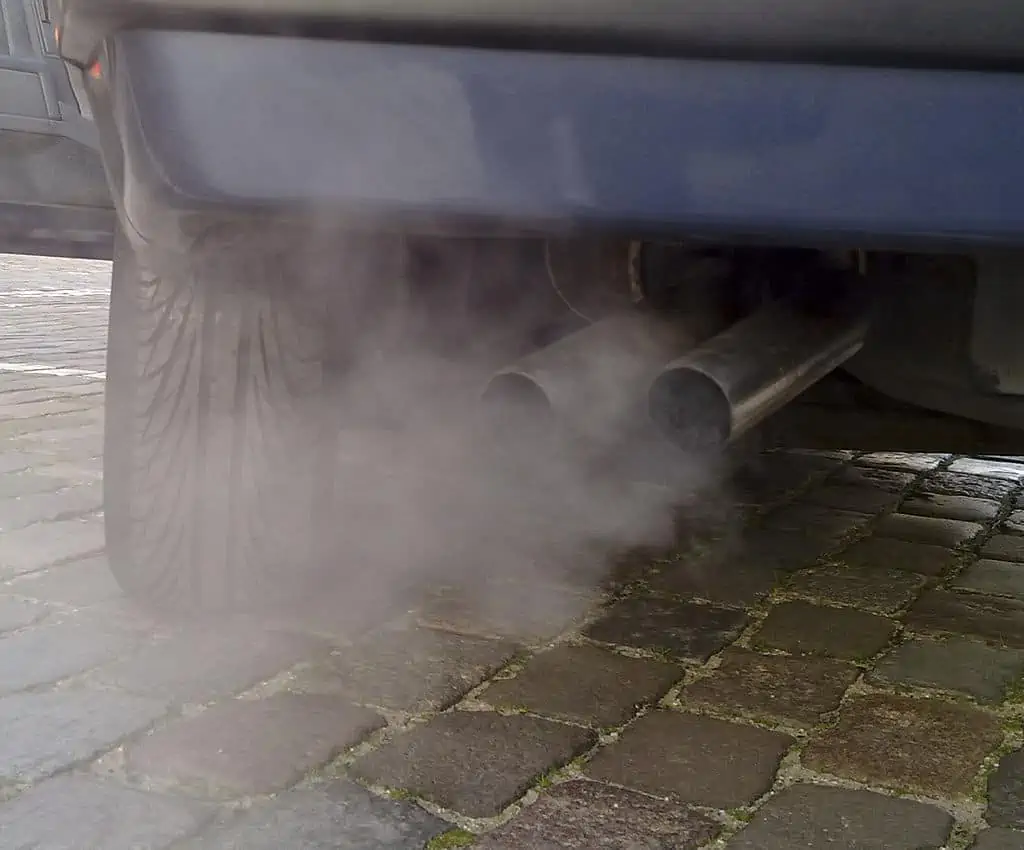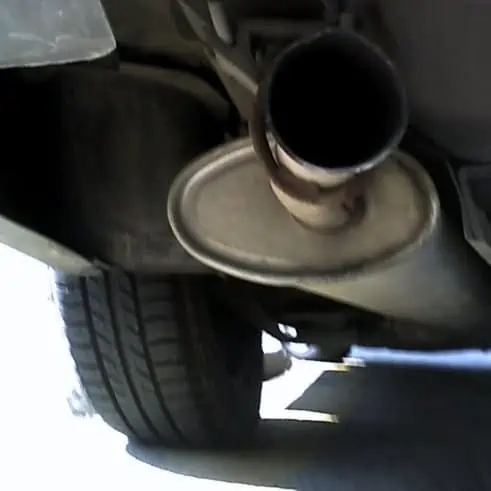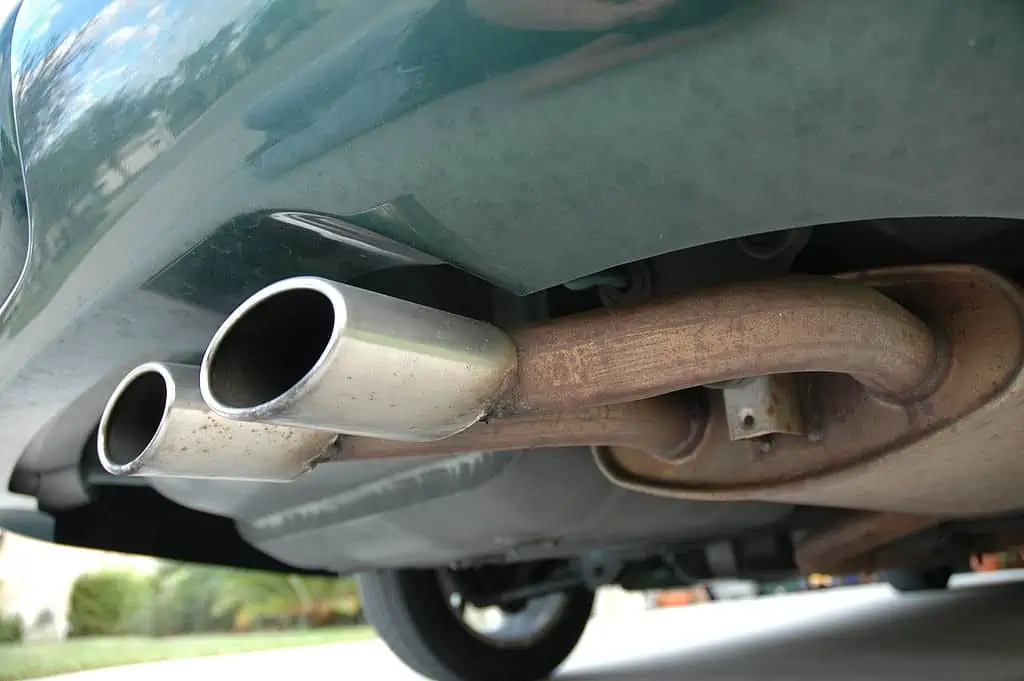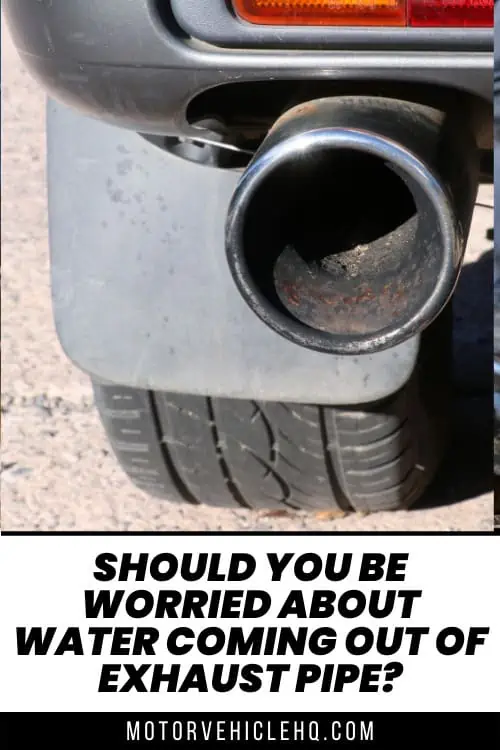When suitably compacted, the fundamentals of how an automobile operates are relatively simple to comprehend. Inside the engine, gasoline and air are compressed, ignited, and burned.
Consequently, power is generated to spin several mechanical parts, which aid in propelling your automobile. Gases are being expelled through your tailpipes and the engine in the meanwhile. What about water coming out of exhaust pipe?
That can’t be natural, can it? As you may expect, when it comes to the combustion process in your automobile, water is not at all an issue. What makes you think that you have been burning water if you can see water coming out of exhaust pipe?
You may notice water coming out of exhaust pipe rather frequently, therefore this situation isn’t unusual. Most of the time, it may be traced to straightforward condensation.
After all, your engine is a hot little thing. You won’t need to worry about anything in this situation. However, there are several circumstances in which water coming out of exhaust pipe might be alarming.
It could be an indication that the engine has major problems that, if fixed straight away, could result in catastrophic failure. So, this explains why water is coming out of exhaust pipe.
The first step in solving this problem is to remain calm and identify the cause of the water coming out of exhaust pipe. People have always been able to properly identify problems with their automobiles and determine the best course of action by using methodical reasoning.
Turning off the engine should be your first action when you notice water coming out of exhaust pipe. Just in case the reason is anything more serious, this is being done.
What Step Should You Take When You Notice Water Coming Out Of Exhaust Pipe?
Once you’ve done that, do the following actions to see if you genuinely have water coming out of exhaust pipe issue on your hands. Or perhaps it’s just condensation.
- Obverse if smoke and water droplets are both coming from the exhaust.
YES: Make a note of the smoke’s hue and density. Is the smoke blue, black, or white? Does it also appear as thin fog or as massive plumes? Something negative might result from this.
NO: On a chilly day, condensation is most often the cause of a fine mist. similar to how you can see your breath when you exhale on a cold morning.
Steam from tailpipe of cold car
Now you may check for odors and, if you’re up for it, taste the liquids seeping out of the exhaust (obviously, dip your tongue into it and properly spit it out afterward).
YES: Does it have a little sweet aroma and flavor? If so, rather than water flowing from the exhaust, it may instead be coolant (or antifreeze, as some may refer to it).
NO: Are you simply smelling the exhaust fumes? Does this fluid not have a unique odor or flavor, or is it just bland? Then it’s probably simply water.
After it is complete, apply some of the fluid to your hands and note how it feels there. Does it feel oily or slick?
YES: If anything seems greasy, it might be unburned fuel or engine oil (gasoline, or diesel). You might also check to see if there are any sparkling drops or puddles close to the exhaust.
NO: Does this substance drip off your hands, leaving them wet? In such an instance, you are once more working with water.
Why Do You See Water Coming Out Of Exhaust Pipe?
When you know what kind of liquid is leaking from the exhaust, you can start to figure out what caused it to happen in the first place.
We must emphasize that observing water traces in the exhaust is generally considered to be natural.
That holds, in particular, if you reside somewhere chilly or if the weather is colder or snowier than typical. In other words, there isn’t currently a reason to be alarmed or worried.
Most of the time, condensation is the cause of water pouring from your tailpipes. Since it indicates that the engine has adequately cooled down, many people interpret it as a positive indication.
And your exhaust is operating flawlessly. In other cases, water is an indication that your engine has been operating at a moderate temperature. It should be anticipated, especially following a day of long-distance traveling or challenging track driving.
As an alternative, water expelling from your tailpipes might be a sign that your catalytic converters are functioning properly. Again, this is not only typical but also construed favorably.
However, there are also quite a few instances where witnessing water coming out of exhaust pipe is unusual. It’s also not a positive indicator of anything other than the major problems your automobile may be having.
Here is a list of the top reasons why water may be flowing from your exhaust, along with tips on how to identify each one.
The Engine’s Condensation
Let’s first get into more detail about the sort of water that is most usually observed coming out of exhaust pipe: condensation from the engine. This is nothing unusual, as we’ve already mentioned. Pollutants are produced during an engine’s conventional combustion process when fuel and air are ignited.
Automobile exhaust by Ruben de Rijcke / CC BY-SA 3.0
Before more gasoline and air are burned to produce more pollutants, these pollutants are first discharged as fumes from the engine. As long as the engine is running, the cycle keeps going. Now tell us what these contaminants (or byproducts) are. Carbon dioxide, nitrogen, and water vapor are the “big 3”.
The implication of this is that water nearly always leaks from your exhaust pipes. However, water is frequently strongly blended with carbon dioxide as well as nitrogen. Water, therefore, escapes as tiny mists that are almost perceptible to the human eye. What about a lot of it, then?
Water vapor can condense inside the exhaust pipes while the engine is cooling down or after you’ve just shut it off. On occasion, you could also notice it oozing from the tailpipes. This is not strange since after a few minutes the drips should stop and go away.
The exhaust, however, can still include a small amount of water. This explains why, occasionally, a blast of water may shoot out of the tailpipes when you switch on the engine. This is very typical as your engine starts up. Simply removing condensation is all that the new combustion cycle does.
The Engine Is Starting To Warm Up Or Is Hot
Engines get rather warm. The internal combustion engine typically operates between 195 and 220 degrees Fahrenheit. At its highest, it may peak at about 250°F. Now, a large portion of this heat is produced when an engine first starts and ignites.
Simply put, your car’s cooling hasn’t attained peak performance at this preliminary phase when the engine is hardly even operating. In other words, once the engine has started, it will take a little longer for the coolant and oil to flow and chill the engine (along with its numerous moving parts).
The engine would continue to heat up as coolant as well as oil are gently moving around before tapering down to a more acceptable running temperature. The exhaust system will also become rather warm as the heat from the engine permeates the remainder of the vehicle.
Again, this will result in some condensation inside your exhaust system, particularly if it is rather chilly outdoors. That water vapor in the exhaust will be forced to escape as soon as your engine starts to expel fumes. This isn’t a sign of a problem, just like with our prior point.
NOTE: This is often quite routine. Give it a few minutes, and the water streaming from the exhaust should cease. However, if water continues to drop from the exhaust pipes after all those few minutes, this could indicate a problem.
The Catalytic Converter’s By-Products
In recent years, catalytic converters have been installed in almost all cars. An engine’s internal combustion process is extremely hazardous. As a result, exhaust fumes have increased everyone’s health risks as well as pollution and a quick increase in carbon emissions.
Fortunately, the development of catalytic converters has resulted in far cleaner air today. A catalytic converter captures the exhaust gasses from your engine through the catalysis process. The most hazardous contaminants can then be transformed or broken down into reasonably safe ones, cleaning them up.
The latter consists of water, and carbon dioxide, which is not ideal but is still far less lethal than other gases. Yes, the chemical catalysis process produces very little amounts of water. These droplets will still be visible when they emerge from the exhaust, though. Again, this is to be anticipated.
Burned Or Defective Head Gasket
Unfortunately, it is the end of the (small) list of risk-free, benign, and typical explanations for why water is pouring from an exhaust. From this point on, we’ve only got bad news after bad news, since water dripping from your exhaust pipes might indicate major problems.
Muffler and tailpipe on a car by Tusanero~commonswiki / CC BY-SA 2.5
The first of several potential head gasket blowouts. The engine block and the cylinder heads are effectively sealed by a thin gasket called a head gasket. In actuality, this aids in sealing combustion gases inside the engine and halts leakage of outside components.
In particular, you wouldn’t want impurities like engine oil, coolant (antifreeze), or other fluids to infiltrate into the combustion chamber and otherwise burn alongside the fuel. Sadly, a head gasket can develop leaks or, as they say, be “blown” over time because it wasn’t designed to endure forever.
As a result, the seals deteriorate, allowing gases to escape the combustion chamber. Meanwhile, the engine might easily develop leaks of oil, coolant, and other substances, leading to more problems. Water coming out of exhaust pipe is one of the signs of a burst head gasket, along with:
- White smoke emerges from the tailpipes in plumes.
- Persistent overheating problems or very high engine temperature.
- Within that coolant (antifreeze) reservoir, there are air bubbles and bubbling.
- Low amounts of coolant and oil due to a leak that has been occurring subtly into the engine.
- Leaking coolant or oil from the exhaust pipes.
NOTE: In any car, a blown head gasket is a serious issue. As a result, you should get the head gasket changed right away and have it checked out by a professional. You will continue to overheat if you delay for a very long time. The latter may harm the engine permanently.
Faulty Piston Rings Or Damaged Pistons
Here’s another unsettling, pricey, and challenging solution if you notice water gushing from your exhaust pipes. In an automobile, the combustion chamber includes the pistons, which are located within the cylinder. The power of this little explosion pulls the piston downward as air and fuel ignite.
The crankshaft is rotated by the pistons as it is driven downward. When power is transmitted to the gearbox and ultimately your wheels, the crankshaft will continue to be driven by the engine’s whole piston assembly. Your engine transfers power through combustion in the same way.
Several piston rings are located in between the pistons as well as the cylinder walls. These rings prevent physical contact between the pistons and cylinder walls, which might be harmful. It also aids in maintaining the seal around the fuel in the combustion chamber.
Additionally, keep motor oil out of the combustion chamber (it naturally flows in the engine’s crankcase for lubrication, behind the pistons). Despite their crucial function, piston rings are prone to wear due to aging. Additionally, the pistons themselves can be broken.
The Corvette C7 has four tailpipes by Alexander Migl / CC BY-SA 4.0
In any event, water pouring from the exhaust might be caused by a broken piston or a damaged piston ring. However, unless its head gaskets also fail at the same time, this is unlikely to happen. In addition to water droplets coming from the exhaust pipes, they may also show additional signs like:
- There is a lot of blow-by inside the engine, which will hurt performance.
- Large volumes of blue or dark-colored smoke that is sooty.
- Around the tailpipes are greasy smears and debris.
- Inside the cabin, there is a burning odor.
NOTE: Defective pistons or even worn piston rings must be replaced right away, much like a blown head gasket.
A Damaged Exhaust Gas Recirculation Cooler (EGR)
An EGR is a typical component in many contemporary autos, just as catalytic converters. They are an attempt to help reduce the finer but more dangerous pollutants in your car’s emissions, such as nitrogen oxide. They can be seen in cars fueled by both gasoline and, most importantly, diesel.
An EGR works to recycle part of the exhaust gases back into the engine, just as the name (exhaust gas recirculation) may imply. As a result, part of the engine’s combustion heat may be absorbed by these vapors, acting as absorbents. The engine can operate more effectively with less heat.
Additionally, the engine performs more smoothly, dependably, and optimally with less combustion heat. A cooler is one of the several elements that make up the EGR system. Before the exhaust gases return to the engine’s intake, this EGR cooler works to cool them down.
The bad news is that an EGR cooler may malfunction sometimes. We must pay more attention to the areas where the coolant is utilized to lower the temperature of the exhaust gases. The EGR cooler’s specific portion is prone to breaking.
Coolant may eventually give way and leak into the exhaust system, eventually being discovered leaking from the tailpipes. There’s a good probability that the fluids dripping from the exhaust are coolant, not water if you happen to smell anything pleasant coming from them.
Even with a damaged and leaky EGR cooler, you can theoretically continue to drive for a time. However, you’ll notice that your car starts to run rougher, shake or vibrate more violently, and you start to hear popping noises coming from the exhaust.
The Aftermath Of Flooding Water
Thankfully, this isn’t as awful as the others. It’s possible that the water coming out of exhaust pipe isn’t even coming from your car. Perhaps the water came from outside and somehow found its way into your exhaust system.
Most of you won’t be affected, but it might still occur. Your automobile is wading in water that is obviously over the tailpipes in this situation, which is frequently observed during flooding. Or perhaps you were driving across a river or even stream and didn’t realize how deep this was.
Dual exhaust pipes attached to a car’s muffler by Steevven1 / CC BY 2.5
The exhaust system may become flooded. This is bad since it could lead to the engine stalling. It shouldn’t take long, though (only a few minutes), once you’re on higher ground, for the water to drain out and be driven out of the tailpipes.
What Is the Cost of Fixing Water Coming Out of Exhaust Pipe?
How do you fix it now that you know what led you to observe water coming out of exhaust pipe? You won’t need to take any action if the problem is condensation from your engine, exhaust, or catalytic converters, though. If, however, your symptoms or diagnosis point to a blown head gasket, damaged pistons, or a malfunctioning EGR, action must be done.
And quickly, as these flaws might eventually cause major engine troubles if they are not resolved right away. Here is a brief explanation of how to resolve them:
Head Gasket That Has Blown
Just a replacement will work as a long-lasting remedy since the complete head gasket has to be changed. In most circumstances, this will cost you a minimum of $1,000. However, the price has been known to soar to $2,000 or even more. That doesn’t take into account further engine damage.
The Piston Rings
These need to be completely replaced. For a complete replacement operation, you may expect to pay between $1,500 and $2,500. However, this cost might go higher to $5,000 or even more depending on the number of cylinders (and therefore, pistons) in your automobile as well as the engine’s complexity.
The EGR Cooling
These require a total replacement since they are difficult to repair. You may be spending as low as $500 on average. The top-end estimate is around $1,500 or more, although it often averages around $1,000.
Conclusion
As you’ve seen, it costs money to fix the issues that might be brought on by water coming out of exhaust pipe. Thousands of dollars are often what you pay. These will mostly be used for labor costs because fixing these problems requires a lot of time and effort.
In many cases, it is more cost-effective to just junk the automobile because the repair prices are so exorbitant. It’s not ideal to have to replace the blown head gasket, piston, ring, or EGR cooler. If nothing else, you can be confident that the water coming from the exhaust is only condensation.
Vapor might be viewed as a very good indicator when it occurs sometimes. As an illustration, recognize that your catalytic converters are operating properly and generating some water as they should.
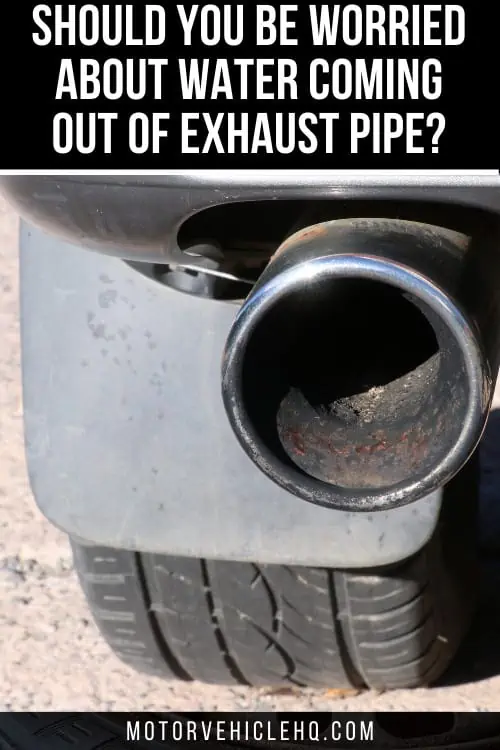

Jim Wicks is the founder of MotorVehicleHQ. With over two decades of experience in the automotive industry and a degree in Automotive Technology, Jim is a certified car expert who has worked in various roles ranging from a mechanic, car dealership manager, to a racing car driver. He has owned more than 20 cars over the past 15 years. Ask him about any vehicle you see on the road and he can tell you the make, model and year. He loves the aesthetics of all things cars, and keeps his vehicles in pristine condition.
In his free time, Jim enjoys getting his hands dirty under the hood of a classic car or taking long drives along the country roads. His favorite car? A 1967 Shelby GT500, a true classic that, according to Jim, “represents the pure essence of American muscle.”
